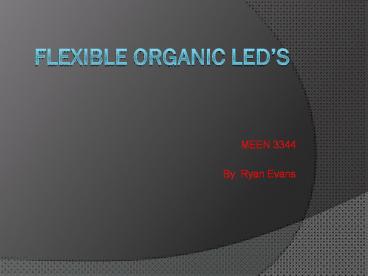Flexible Organic LED - PowerPoint PPT Presentation
1 / 6
Title:
Flexible Organic LED
Description:
MEEN 3344 By: Ryan Evans What the Flexible Organic Light Emitting Diode Consist of : The Top Layer is the Cathode layer made of tungsten releases electrons when ... – PowerPoint PPT presentation
Number of Views:233
Avg rating:3.0/5.0
Title: Flexible Organic LED
1
Flexible Organic LEDs
- MEEN 3344
- By Ryan Evans
2
What the Flexible Organic Light Emitting Diode
Consist of
The Top Layer is the Cathode layer made of
tungsten releases electrons when current is run
through it. Emissive Layer removes electrons
from the cathode layer to make light. Conductive
layer is made from a type of organic plastic that
removes the electron wholes Then the Anode Layer
that consist of removing and adding electron
holes while the current is running through it and
is made from graphite particles Followed by the
Substrate layer is used to support the Organic
LED and is made up of glass, clear plastic
3
Some Advantages of Using Organic LEDs
The Flexible Organic LED is easily mass produced
because of its unique ability to be printed out
on Ink Jet printers and sometimes Screen Printing
Technologies. The enable people to see a wide
ranged of colors and sit from almost any angle
without degrading the picture quality even at 90
degree angles. It also has the unique ability to
use less energy because of how its made up and
has better response time than other LEDs. The
problem of the longevity of the Organic LED has
been over come by adding a thin sheet of metal in
with it.
4
Commercial Uses of the Organic LED
5
- References
- Callister William D. Jr and Rethwisch David G.
(2008). Fundamentals of - Materials Science and Engineering An Integrated
Approach. John Wiley and Sons inc. (2007). Pg 777 - O. Prache, "Active matrix molecular OLED
microdisplays", Displays Volume 22, Issue 2, May
2001, Pages 4956.
http//www.scienceofspectroscopy.info/edit/index.p
hp?titleOLED
http//www.newlaunches.com/archives/sony_xel1_oled
_tv_available_for_preorder.php
http//www.inhabitat.com/2008/01/08/samsungs-super
-sleek-31-oled-tv/ by Ali Kriscenski
http//www.voidspace.org.uk/technology/top_ten_pho
ne_techs.shtmloled-displays
D. Ammermann, A. Böhler, W. Kowalsky, Multilayer
Organic Light Emitting Diodes for Flat Panel
Displays, Institut für Hochfrequenztechnik, TU
Braunschweig, 1995.
http//www.lifeatmost.com/smartphone/nokia-n85-spo
tted-maybe/
6
References Continued
http//i-eclectica.org/2007/03/11/
Posted by isiria, in DESIGN, IT Hardware
http//www.universaldisplay.com/
Information taken by this person from
D. A. Pardo, G. E. Jabbour, N. Peyghambarian,
Application of Screen Printing in the Fabrication
of Organic Light-Emitting Devices, Adv. Mater.
2000, 12, No. 17, 1249.

